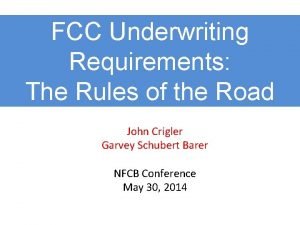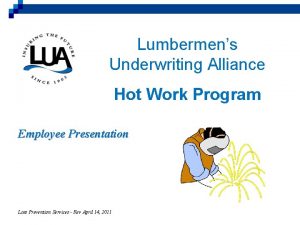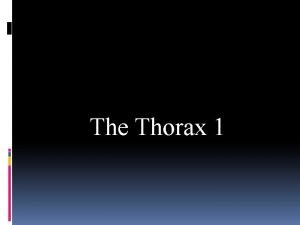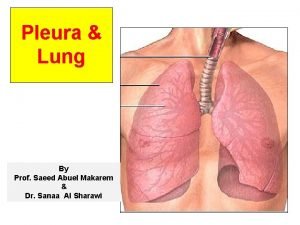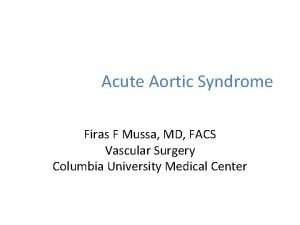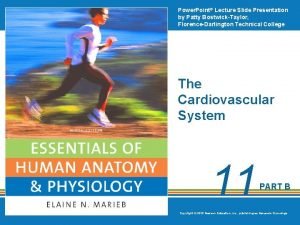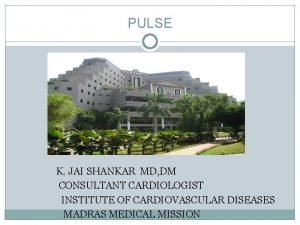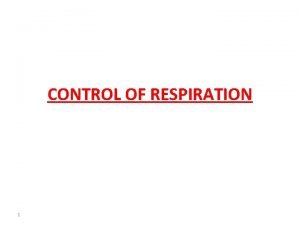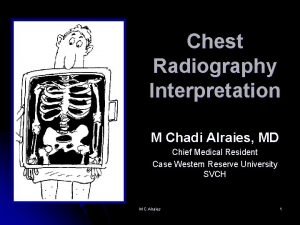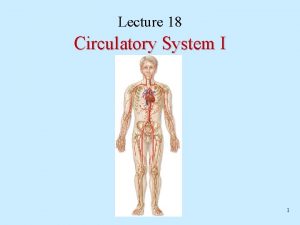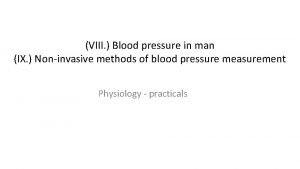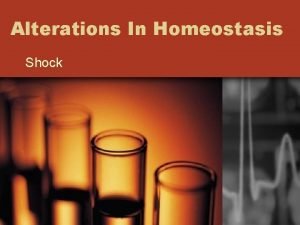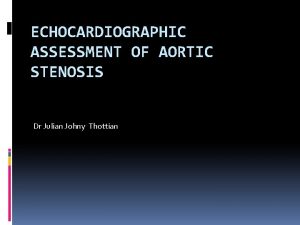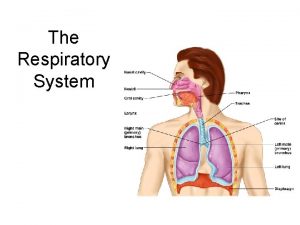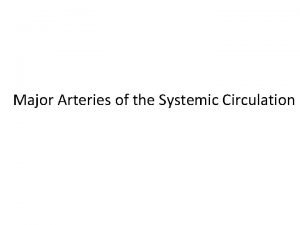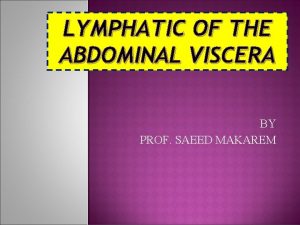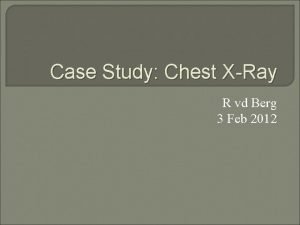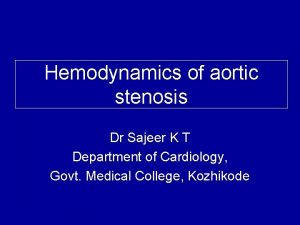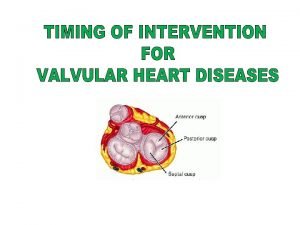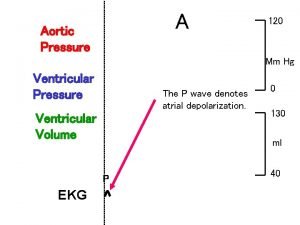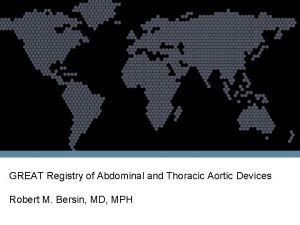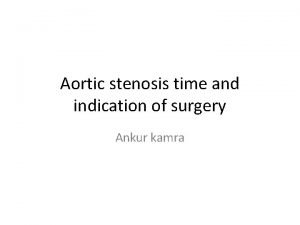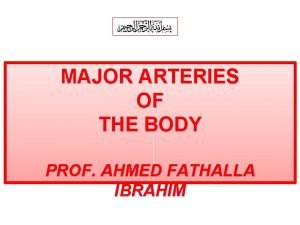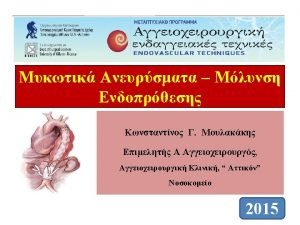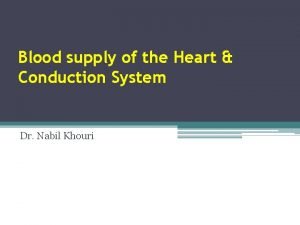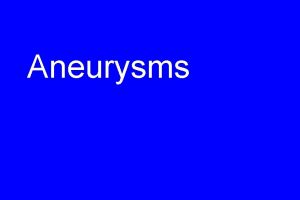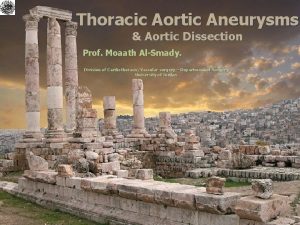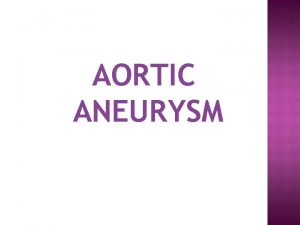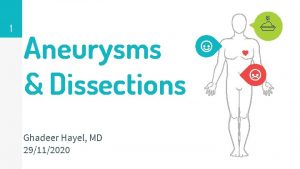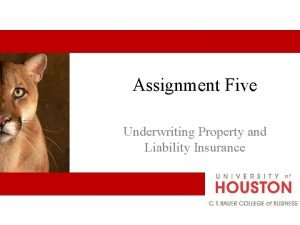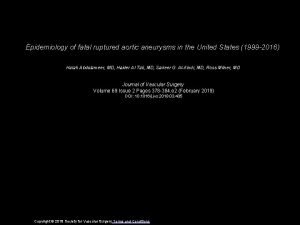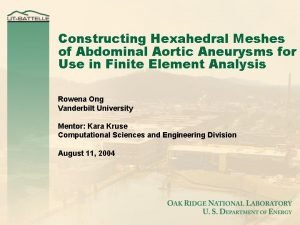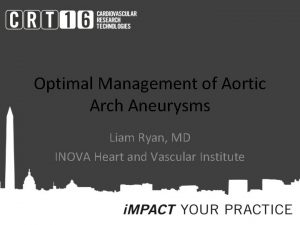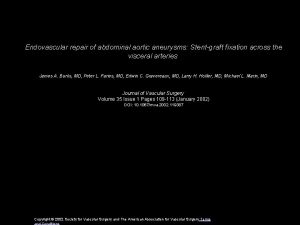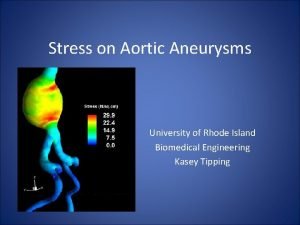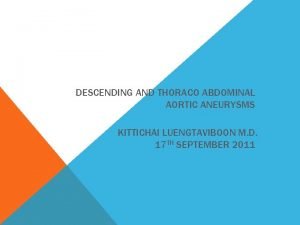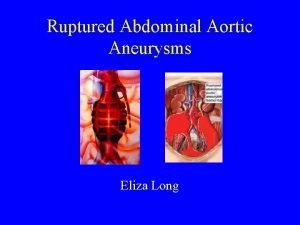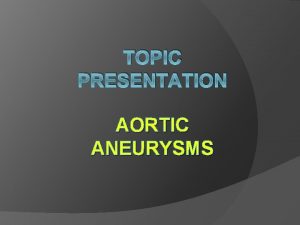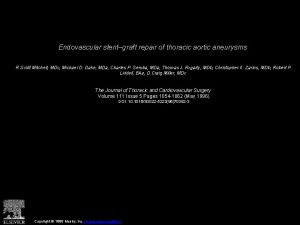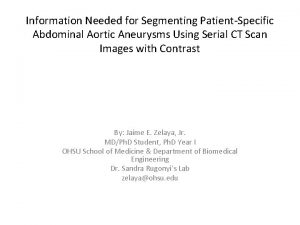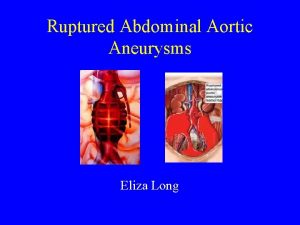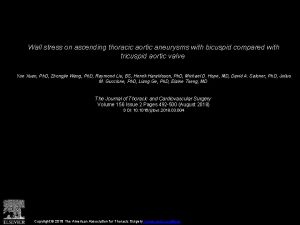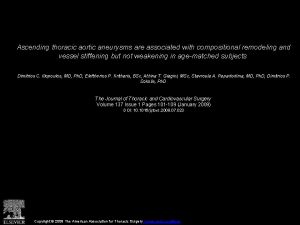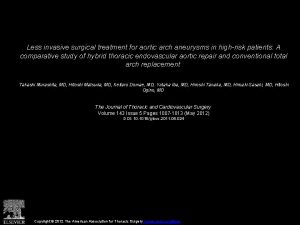Aortic Aneurysms Optimum Re Underwriting Seminar Dallas 2015









































- Slides: 41

Aortic Aneurysms Optimum Re Underwriting Seminar Dallas 2015 Jean-Marc Fix, FSA, MAAA VP R&D

Thanks • • Dr. M. Nguyen Dr. Z. Sasson Dr. F. Sestier and Dr. A. Khoury

Agenda • • • Anatomy of the aorta Aneurysm definition Thoracic aortic aneurysm Abdominal aortic aneurysm Case studies

Anatomy of the Aorta Source : clevelandclinic. org

Definition of Aneurysm • Local dilatation of the aorta o by over 50% over the normal diameter and o involving all three layers of the vessel (intima, media and adventitia) • Abdominal aneurysm more common than thoracic

Morphology of Aneurysm • Fusiform: symmetrical • Saccular: pouch

Cause • A weakening of the aortic wall o Trauma or infection o Defect in aortic walls proteins o Age

Consequences • Expansion • Rupture • Death

Distribution by Age ORIC all aneurysms 30 Number of cases 25 20 15 10 5 0 25 -34 35 -44 45 -54 55 -64 Issue Age 65 -74 75 -85

Mortality by Age From Pharmaceuticalintelligence. com but specifics of chart not clear

Thoracic Aortic Aneurysm • • Epidemiology Etiology Treatment Mortality and rating

TAA Epidemiology • Incidence 6 -10/100, 000 • Prevalence 0. 16 -0. 34% for 5 cm+ undetected • Most common your 60 s and 70 s • Males 2 -4 times more than female • 13% have multiple aneurysm • 20 -25% of large TAA also have AAA Source : GA Kuzmik et al Natural history of thoracic and aortic aneurysm, J Vasc Surg 2012 56: 565 -571, EM Isselbacher Thoracic and aortic aneurysm, Circulation 2005 111: 816 -828

TAA Anatomy • Ascending (between aortic valve and innominate artery) 60% • Aortic arch 10% • Descending (distal to left subclavian artery) 40% • Thoracoabdominal 10% • (more than I segment possible) Source : EM Isselbacher Thoracic and aortic aneurysm, Circulation 2005 111: 816 -828

TAA Causes • Most often cystic medial degeneration (increases with age) • Marfan syndrome • Familial TAA Syndrome • Bicuspid aortic valve (have a fibrillin defect) • Atherosclerosis (mostly for descending TA, maybe secondary) [ZS 5 a] Source : EM Isselbacher Thoracic and aortic aneurysm, Circulation 2005 111: 816 -828

TAA Causes • • Syphilis Turner syndrome Aortic arteritis (Takaysu’s and giant cell) Aortic dissection Trauma (often deceleration injuries) Ehlers-Danlos syndrome Rheumatoid and psoriatic arthritis Source : EM Isselbacher Thoracic and aortic aneurysm, Circulation 2005 111: 816 -828

TAA Clinical Manifestation • 95%+ asymptomatic • Sometimes mass may create compression of trachea or main bronchus, esophagus or laryngeal nerve • Rarely back or chest pain • Rupture: abrupt onset of severe pain Source : GA Kuzmik et al Natural history of thoracic and aortic aneurysm, J Vasc Surg 2012 56: 565 -571, EM Isselbacher Thoracic and aortic aneurysm, Circulation 2005 111: 816 -828

TAA Diagnosis • CT scan or MRI • In Marfan’s especially, transthoracic echo (good only for the root) Source : EM Isselbacher Thoracic and aortic aneurysm, Circulation 2005 111: 816 -828

Dimensions of the Thoracic Aorta Evangelista A et al. Eur J Echocardiogr 2010; 11: 645 -658

TAA Imaging CT Source : EM Isselbacher Thoracic and aortic aneurysm, Circulation 2005 111: 816 -828

TAA Imaging CT -2 Source : EM Isselbacher Thoracic and aortic aneurysm, Circulation 2005 111: 816 -828

TAA Imaging MRI Source : EM Isselbacher Thoracic and aortic aneurysm, Circulation 2005 111: 816 -828

TAA Natural History • Aorta loses flexibility when reaching 6 cm and can’t absorb extra blood pressure • Ascending aorta grows by 0. 10 cm a year • Descending aorta grows by 0. 29 cm a year • Familial TAA grows faster

TAA Natural History • Rupture is key danger o 41% reach hospital alive o Perioperative mortality 23 -29% • Non emergency surgical mortality 35%

TAA Management • Surveillance • Surgery

Treatment • Surgical repair o Open o Endovascular

TAA Repair NO Size 3. 5 -4. 4 cm Size 5. 5 cm or + Growth 0. 5 cm/yr Symptomatic Size 4. 5 -5. 4 cm YES Surgical candidate CAD/Valve issue YES Annual CT/MRI NO NO Semi-annual CT/MRI Valve/ CABG + aneurysm repair Aneurysm repair

Types of Surgery • Open surgery • Endovascular aneurysm repair

Pros and Cons • Open repair (from the 1950 s) o Pros: stable, handle any aortic geometry o Cons: invasive, circulation stopped, higher perioperative mortality and complications (x 2 EVAR) • EVAR (from the 1990 s) o Pros: less invasive, faster recuperation o Cons: less stable in time, need conducive aortic geometry, follow-up and reintervention may be needed

EVAR Follow-Up • Need CT scan 30 days after operation • Done in about 1/3 cases! • Then annual imaging Source : T Garg Adherence to postoperation surveillance guidelines after endovascular aortic repair among Medicare beneficiary, Stanford School of Medicine 2012(? ) 111: 816 -828

TAA Rating Factors • Pre surgery o Growth rate o Size o Age • Post surgery o Age o Type of surgery o Time since surgery

Abdominal Aortic Aneurysm • • Epidemiology Etiology Treatment Mortality and rating

AAA Epidemiology • Much more common • Aneurysm 4 cm+ in 1% of men ages 55 -64 and increase by 2 -4% per decade • Incidence rise rapidly after age 50 for men and 70 for women • Less common in women Source : EM Isselbacher Thoracic and aortic aneurysm, Circulation 2005 111: 816 -828 JT Powell Small abdominal aortic aneurysm < NEJM 2003 348: 1895 -1901

AAA Causes and Risk Factors • • • Smoking Hypertension Hyperlipidemia Atherosclerosis Family history (could increase risk by 30%, younger age, more likely to rupture) • Males 10 times more likely to have aneurysm>4 cm than females Source : EM Isselbacher Thoracic and aortic aneurysm, Circulation 2005 111: 816 -828 W Tang et al Association between middle age risk factors and risk of asymptomatic AAA (ARIC study )Circulation 2014 129: AP 341

AAA Clinical Manifestation • Mostly asymptomatic • Found incidentally • If pain , it is usually below the stomach or in the lower back • If abrupt violent back pain and tender or painful abdomen -> ER Source : EM Isselbacher Thoracic and aortic aneurysm, Circulation 2005 111: 816 -828

AAA Diagnosis • May be detected by palpation • Ultrasound prefer detection modality • CT scan and CT angio better for sizing and therefore for follow-up • Size by CT is 3 -9 mm greater than by ultrasound (depending on the aneurysm size) Source : EM Isselbacher Thoracic and aortic aneurysm, Circulation 2005 111: 816 -828

AAA Natural History • Rupture is also key danger o 25% die before reaching the hospital o 51% die prior to surgery o 46% of those having surgery die! • Elective is best and combine with aortic valve surgery if needed

AAA Natural History • Rupture is more frequent o In smokers o In hypertensive o In fast growing aneurysm

AAA Management • Surveillance frequency depends on size o 4. 0 -4. 4 cm every 2 years o 4. 5 -4. 9 cm every year • Surgery o When 5. 5 cm+ o When growth of 10 mm+/year Source : 2014 European Society of Cardiology guidelines on the diagnosis and treatment of artic diseases

Pros and Cons for AAA Trial 30 days mort. Long term mort. EVAR/Open EVAR 1 1. 8%/4. 3% 23. 1%/22. 3% (4 y) DREAM 1. 2%/4. 6% 31. 1%/30. 1% (6 y) OVER 0. 5%/3. 0% 7. 0%/9. 8% (2 y) Medicare 1. 2%/4. 8% 34. 0/34. 3% (5 y) • EVAR has short term advantage but does not seem to sustain that advantage over open surgery longer term. Why is still unclear! Source : Table 1 A Schanzer & L Messina Two decades of endovascular aortic aneurysm repair: enormous progress with serious lessons learned, J Am Heart Assoc 2012 1: e 000075

AAA Screening • Medicare covers one abdominal ultrasound for adults age 65+

AAA Rating Factors • Pre surgery o Growth rate o Size o Age • Post surgery o Age o Type of surgery o Time since surgery
 Fcc underwriting rules
Fcc underwriting rules Types of firm underwriting
Types of firm underwriting Hpap underwriting guidelines
Hpap underwriting guidelines Royal london medical underwriting limits
Royal london medical underwriting limits Lumbermens underwriting alliance
Lumbermens underwriting alliance What is debenture
What is debenture Wind and hail insurance biloxi ms
Wind and hail insurance biloxi ms Debt underwriting
Debt underwriting Glemham underwriting
Glemham underwriting Insurance underwriting process diagram
Insurance underwriting process diagram Dvi in echo
Dvi in echo Thoacic
Thoacic Pulmonary ligament
Pulmonary ligament Firas mussa
Firas mussa Aortic arch branches
Aortic arch branches Aortic vestibule
Aortic vestibule Peripheral signs of aortic regurgitation
Peripheral signs of aortic regurgitation Aortic body
Aortic body X-ray
X-ray Branches off aortic arch
Branches off aortic arch Heart parts
Heart parts Aortic pressure curve
Aortic pressure curve Aortic stanosis
Aortic stanosis Aortic valve leaflets
Aortic valve leaflets Continuity equation echo
Continuity equation echo Pleura location
Pleura location Major arteries of the systemic circulation
Major arteries of the systemic circulation Left lymphatic duct
Left lymphatic duct Good morning blood
Good morning blood Interruption of the aortic arch
Interruption of the aortic arch Pulmonary aortic window
Pulmonary aortic window Valvulo arterial impedance
Valvulo arterial impedance Sircumflex
Sircumflex Regurgitatiom
Regurgitatiom Semilunar
Semilunar Type b aortic dissection
Type b aortic dissection Stages of aortic stenosis
Stages of aortic stenosis Aortic regurgitation murmur
Aortic regurgitation murmur Branches off aortic arch
Branches off aortic arch Pathophysiology of aortic aneurysm ppt
Pathophysiology of aortic aneurysm ppt Thebasian veins
Thebasian veins Bony chest female
Bony chest female
